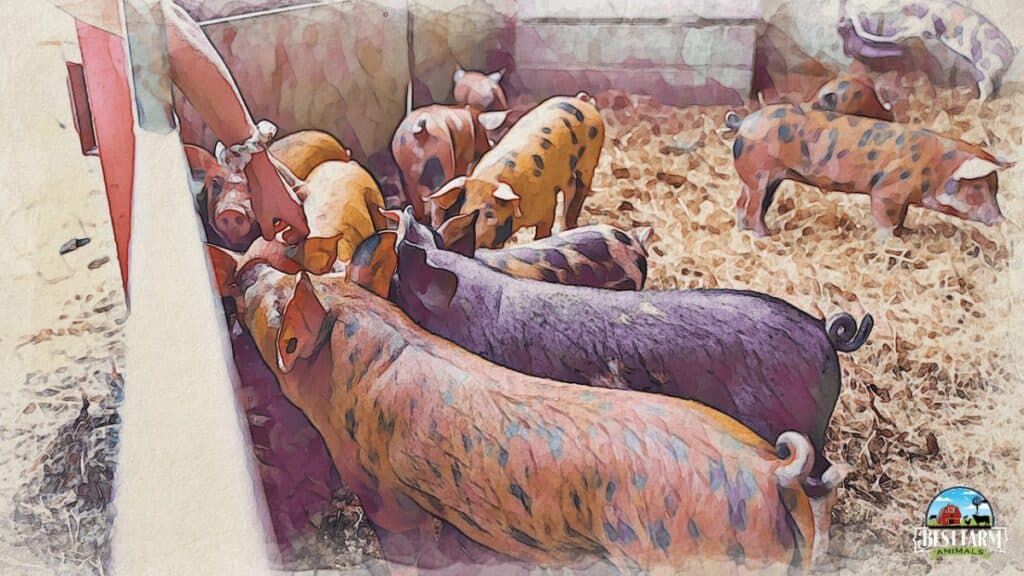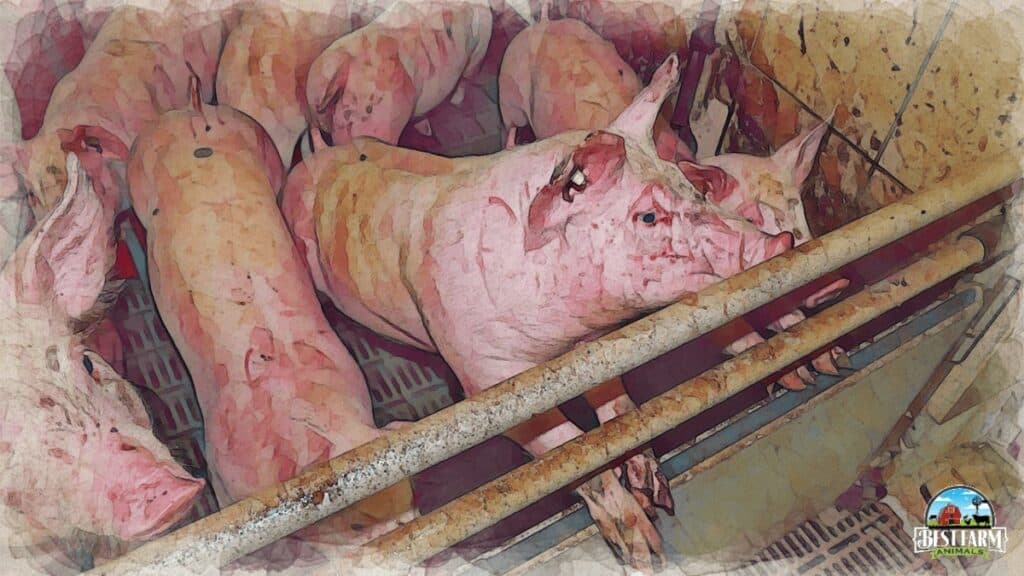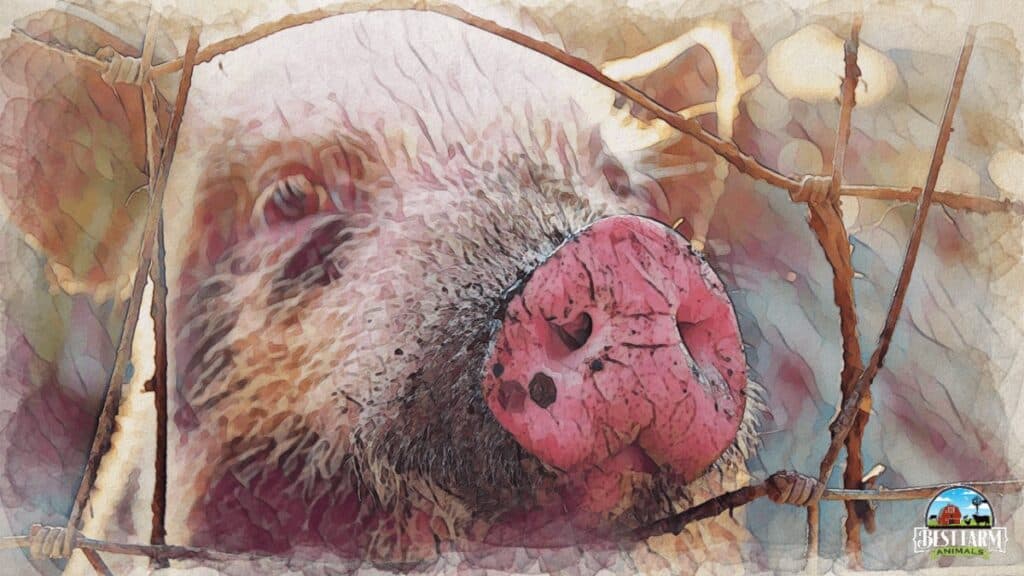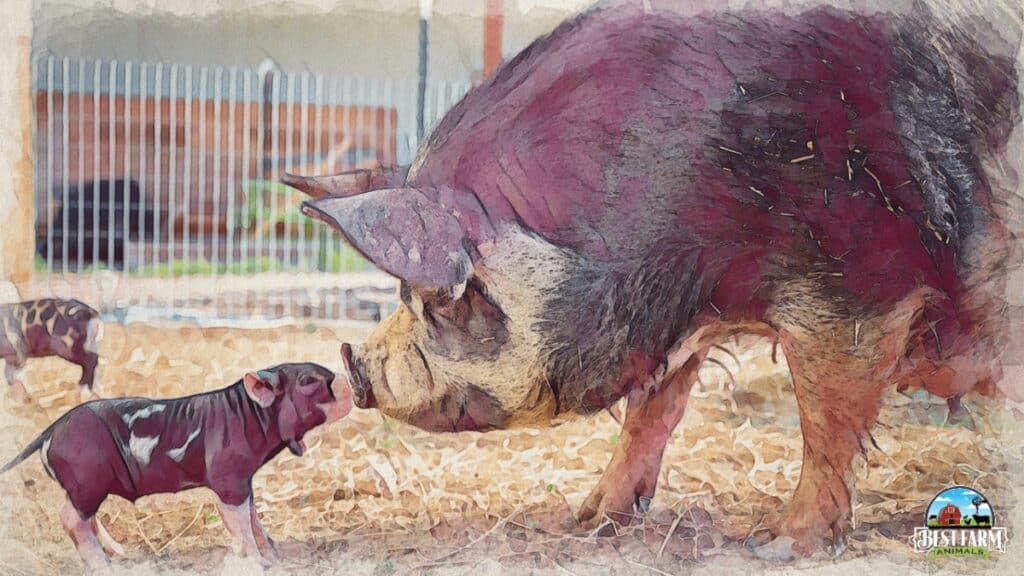I’ll never forget our experience with pig savaging. When I heard Lisa scream next to the enclosure where we keep the breeding sow, I knew it was something serious. As I came around the corner of the house, my daughter ran to me in tears. “Mommy, Sally is eating her babies!”
Sally is our spotted pig; she had a litter of five little piglets. And half a day later, a sixth piglet appeared. This little runt of the litter was very weak, so I was expecting that he would die despite our best efforts. It seems that Sally decided to move things along a bit.
After my daughter went back to the house, I inspected the pigsty. I checked on the remaining healthy piglets—they were all still there. Sally had munched about half of the sickly piglet. So I shooed her away and cleared away the remains.
Sows usually eat their babies for one of several common reasons. Understanding those reasons can help you to prevent the situations that induce savage.
How do you stop a pig from savaging? You can reduce pig savaging by handling sows cautiously, especially around and after farrowing. Giving birth is stressful for sows. Feed sows and decreases stress to lower the incidents of sow savage. Sows that have a pen with nesting materials and a quiet area don’t eat their pigs as much.
It’s simple, but there are a number of factors that create savage behavior. Understanding the stressors that cause savaging makes it easier for you to stop your sow from killing her babies. Let’s dive into 11 things you can do to stop savaging.
- Pig Cannibalism: When Sows Eat Their Own Babies
- 11 Steps to Stop A Pig From Savaging
- 1. Gentle and Calm Handling can Prevent Savagery
- 2. Creating a Stress-free Environment Reduces Aggression
- 3. Supervising Farrowing can Improve Survival Rates
- 4. Sows Given Nesting Materials are Less Aggressive
- 6. Farrowing Pen Can Promote Positive Maternal Behaviors
- 7. Muzzling Aggressive Gilts can Reduce Savagery
- 8. Reduce the Pain of Farrowing, Reduce the Aggression
- 9. Feeding Prior to Farrowing Can Limit Agitation
- 10. Maintaining a Sow’s Optimal Weight May Reduce Cannibalism
- 11. Separating Piglets From the Sow Can Reduce Piglet Deaths
- Are Pigs Cannibals FAQs
- Conclusion
- References
Pig Cannibalism: When Sows Eat Their Own Babies
When pigs are cannibals, it’s caused mainly because of the maternal aggression that sows experience. Limited space and sudden noises may also trigger a pig to eat her own baby. Eating a stillborn piglet is a natural behavior for sows. Leaving a dead body lying around increases the risk of infection and attracts the attention of predators.
Removing a dead body while consuming her afterbirth is one thing, but actively attacking her offspring is quite another.
11 Steps to Stop A Pig From Savaging
Taking proactive steps to prevent sow savaging can increase the survival rate of your litter by as much as 10%. Pigs are cannibals, but not super commonly. It’s usually caused by high stress. Taking many of these steps may seem common sense but, at the moment, is often forgotten.
1. Gentle and Calm Handling can Prevent Savagery
Human attitudes affect the behavior of domestic pigs. An annoyed handler working with a gilt or sow can harm that animal’s maternal behavior. Making excessive noise or failing to feed on time can also increase the pig’s levels of aggression.
Sticking to a set schedule and going about your tasks calmly and quietly can improve maternal behavior and reduce the risk of savagery among gilts and pigs.

2. Creating a Stress-free Environment Reduces Aggression
When we were still new to pig farming, we allowed several visitors into the enclosure where one of our gilts had just given birth to a litter of 10. The gilt quickly became restless. She walked up and down the enclosure with her head raised, grunting. We quickly left the enclosure, but the damage was already done. When we returned 30 minutes later, three piglets had been trampled or crushed to death. The next day, the death toll was even higher.
In the end, that gilt raised just one piglet from her original litter. At the time, we didn’t realize our behavior had anything to do with her destructive tendencies.
However, it soon dawned on us that allowing strangers into the enclosure contributed to her stress and exacerbated her aggression.
These days, we leave the sows alone when they first show signs of farrowing. Pigs usually stop eating several hours before farrowing. Then, we move them to a straw-lined enclosure and leave them in peace. Our subsequent litters have all proved healthy, and the number of deaths has dropped to one or two.
3. Supervising Farrowing can Improve Survival Rates
Savagery and pig cannibalism usually occur within the first 48 hours after farrowing. Removing the piglets to a place of safety for this period can improve survival rates. Piglets are more likely to be crushed, bitten, or savaged in the first couple of days and are at greater risk of contracting a disease. Supervising farrowing and suckling also gives the smaller, weaker piglets a better chance of getting their nutrition.
Farrowing crates were designed so that sows could give birth and suckle their babies safely without the risk of crushing. Unfortunately, there’s also evidence to suggest that they increase “savagery behavior.”
A more humane approach involves providing your sows with nesting materials.
4. Sows Given Nesting Materials are Less Aggressive
If you give a sow straw to nest in, you should see “a lower frequency of negative communication towards piglets.” If free to build a nest from straw, sows will also engage in more positive, successful nursing bouts and communicate more positively with their piglets.
Promoting positive communication appears to reduce the crushing frequency, increasing the sow’s responsiveness to the cries of her piglets.

6. Farrowing Pen Can Promote Positive Maternal Behaviors
Crating the sow in a farrowing pen that protects the piglets from being crushed. It also encourages positive material behavior that can reduce the incidences of savagery and piglet deaths. Farrowing pens are designed to prevent the sow from turning around and crushing her piglets.
Sows should be introduced to the farrowing pet a week before farrowing so that the change in location doesn’t increase her stress during the birthing process. A farrowing pen is used for the first week of the piglets life to prevent the sow from crushing her babies.
Make it easier on the sow by Including straw or similar bedding in the pen. You can also create areas that are accessible to the piglets but too small for the sow to enter. This approach gives the piglets a safe place to escape negative maternal behaviors.
Sows should not be kept in a harrowing pen for months at a time. 2-3 weeks is the appropriate length of time to use a harrowing pen.
7. Muzzling Aggressive Gilts can Reduce Savagery
It is possible to stop a pigs from eating their babies by purchasing or making a muzzle for the sow. A muzzle will make it impossible for the sow to bite her piglets and impede eating and drinking.
Remove the piglets to a safe place while your sow is drinking and eating, returning them only once she’s finished and the muzzle is back in place.
You can use an old Wellington boot to make a muzzle for a particularly aggressive gilt. Cut off the foot of the boot and place the leg over the pig’s snout. Use baling twine to secure the muzzle, ensuring it’s not too tight.
If you don’t have any old boots lying around, you can always invest in a custom-made pig muzzle. Alternatively, you could use a dog muzzle if you can find one designed for large breeds. The advantage of using a dog muzzle like this one is that your pig will still be able to drink while wearing it.
8. Reduce the Pain of Farrowing, Reduce the Aggression
A sow in pain during farrowing is more likely to demonstrate negative behaviors towards her offspring. Her piglets may also be smaller and weaker, making avoiding those behaviors more difficult.
High pain levels during farrowing are often linked to higher levels of aggression afterward. Providing pain killers to gilts that show signs of hostility or restlessness during farrowing can reduce the incidents of cannibalism and savagery after birth.
Veterinary practitioners often administer the non-steroidal anti-inflammatory drug, Meloxicam to sows around farrowing. It reduces pain, increases post-farrowing recovery, and enhances piglet growth at weaning.

9. Feeding Prior to Farrowing Can Limit Agitation
Many pig owners stop feeding their sows a few hours before they start farrowing. All the sows we’ve observed over the past ten years stop eating around this time by choice.
However, some researchers believe there could be a connection between the sudden drop in food intake before farrowing and the sow’s levels of agitation and aggression.
Instead of providing your sow with her usual diet of compound feed, you could substitute it with bran.
This method gives your sow something to eat so it may reduce her levels of agitation, but without causing the potential “milking and physical problems” associated with a rich diet.
10. Maintaining a Sow’s Optimal Weight May Reduce Cannibalism
Scientists suspect there is a link between excessive body condition and cannibalism and savagery in sows.
Breeding sows require fewer nutrients towards the end of their gestation period than at other times in their lives. Feeding a high-protein diet at this time may increase weight gain and promote cannibalism. A low protein, high fiber diet can prevent such weight gain and lower the possibility of negative maternal behaviors.
A diet that includes beet pulp, wheat bran, soy hulls, or alfalfa will adequately prepare your pig for farrowing without causing excessive body condition.
11. Separating Piglets From the Sow Can Reduce Piglet Deaths
Separating the piglets from the sow during the mama’s feeding times can reduce incidents of savaging. Combined with a muzzle for aggressive sows, separating piglets can eliminate and increase baby survival rates. For sows that accidentally kill their babies, a farrowing pen helps to provide needed space to the babies without fully separating the piglets from the mama pig.

Are Pigs Cannibals FAQs
Do pigs eat dead pigs? Pigs eat dead pigs and are not particular about the type of meat they can chew even when its cannibalistic behavior. Pigs eat almost anything they can chew, so when a pig dies, maybe from cannibalism, and is not removed from where the other pigs are, the other pigs will feast on the carcass. The pigs may only leave the carcass if it is rotten.
How Many Piglets can a Pig have? The average litter size for most pigs is between seven and eight, although some sows may produce as many as 12 to 14 piglets in a single litter. Pigs can have 2 healthy litters a year. Sows carry their litters for 114 days before giving birth. Pigs can have a maximum of 13-16 pigs in a parity.
How Long is a Pig Pregnant? Pigs are pregnant for three months, three weeks, and three days. They’ll give birth within 111 to 120 days of mating. The average pig pregnancy is 114 days. After piglets are weaned, a sow can be bred within 5-7 days. Pigs can have up to two healthy pregnancies each year.
Do Pigs Eat Bacon? Pigs are omnivores and aren’t too fussed about what they eat. They won’t think twice about eating bacon if you offer it to them. But it’s not a good idea to feed your pig raw meat of any description. Uncooked meat can transfer diseases such as foot and mouth disease.
You also don’t want your pig getting a taste for fresh meat. One of our sows managed to get into an enclosure with a couple of young goat kids and, having eaten one, she became very determined in her attempts to finish the other.
Conclusion
While the idea of an animal eating its own kind is quite objectionable to most of us, cannibalism is not unheard of in the animal kingdom. I knew we had to take steps to ensure Sally wouldn’t eat the rest of her piglets, but it didn’t really surprise me that she had done so. Nature has a way of dealing with ill or ailing animals, and nothing goes to waste. While this may sound cruel, it’s simply a fact of life.
References
National Animal Disease Information Service:
Farm Animal Welfare EC:
My Most Used Pig Supplies
This list contains affiliate products. Affiliate products do not cost more but helps to support BestFarmAnimals and our goal to provide farm animal owners with accurate and helpful information.
Purina Pig Chow will last well (or Mazuri is popular, but I haven’t tried it), and the stainless steel non-skid bowls that will help keep the mess down.
A pig blanket to keep her warm. This one also has bright colors and helps to provide rooting without the destruction.
Pig Harness for walking and handling your pig. There are a lot to choose from, but this one is pretty easy to use. If you want one that has a separate leash, this looks like a good one.
A large crate for keeping her safe in your house at night and when you leave the house. This is essential. You’ll also want a litterbox, and I like mine with a lid for nighttime. Pine shavings are best, and you may be able to find them in larger quantities locally.
When you have accidents, Odoban will help eliminate odors. When you are potty training, these floor pads work great for keeping your house clean while training her to go in certain places.
You’ll also want an outdoor house to keep her warm when she gets outside time, an essential part of her development.
Dewormer- Ivermectin is the primary dewormer I use, although I do rotate with a non-ivermect ingredient once so that the worms don’t get immune to it.

